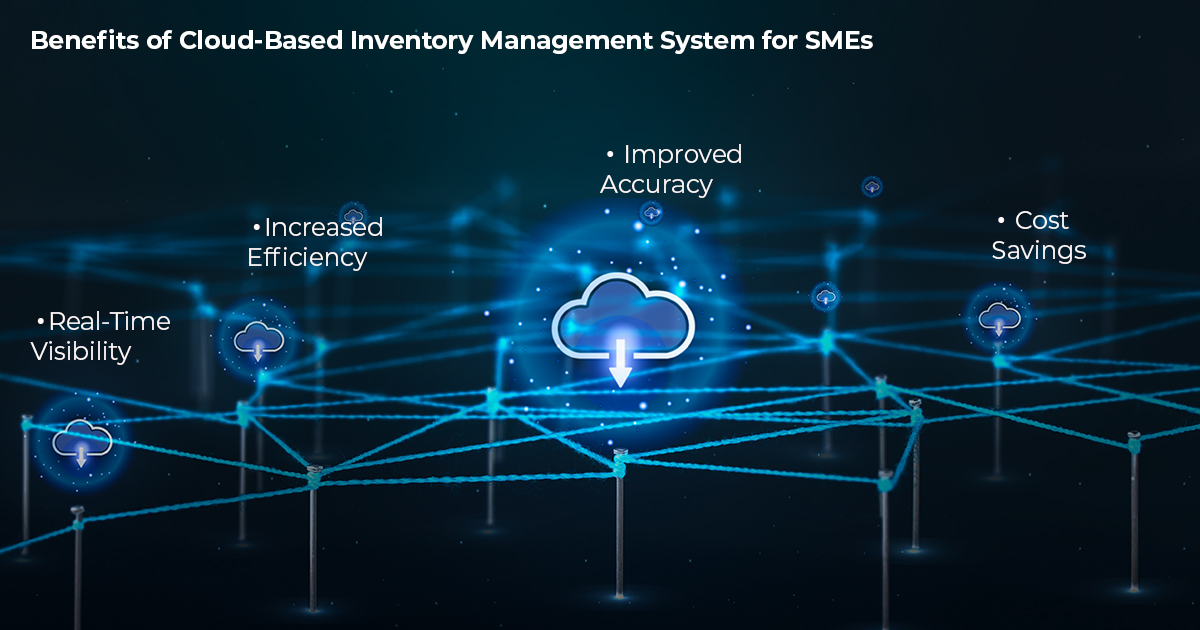Why SMEs Need Cloud-Based Inventory Management System?
Small and medium-sized enterprises (SMEs) often operate with limited resources and budget constraints. For such businesses, managing inventory can be a daunting task, especially if they rely on manual processes or outdated inventory management systems. However, with the advent of cloud-based inventory management systems, SMEs can now manage their inventory more efficiently, cost-effectively, and with greater accuracy. This blog post highlights the key reasons why small and medium sized businesses require cloud-based inventory management software.
also read :Why Do ERP Implementations Fail For Businesses?
What Is Cloud-Based Inventory Management?
Cloud-based inventory management is a web-based software that allows SMEs to manage their inventory from anywhere at any time. Unlike traditional inventory management systems that are installed on-premises, cloud-based inventory management systems are hosted on remote servers and accessed through the internet.
Benefits of Cloud-Based Inventory Management for SMEs
👉 Real-Time Visibility
With a cloud-based inventory management system, SMEs can access real-time inventory data from anywhere at any time. This means that businesses can keep track of their inventory levels, monitor stock movements, and make informed decisions about when to reorder and how much to reorder. Real-time visibility also enables businesses to identify and respond quickly to inventory issues, such as stockouts or overstocking.
👉 Increased Efficiency
Cloud-based inventory management systems automate many of the manual processes associated with inventory management, such as data entry, order processing, and reporting. This reduces the time and effort required to manage inventory and frees up staff to focus on other business activities. For example, businesses can set up automatic reorder points, receive notifications when inventory levels are low, and track inventory movement between locations.
👉 Improved Accuracy
Manual inventory management processes can lead to errors and inaccuracies, which can have significant consequences for SMEs. Cloud-based inventory management systems reduce the risk of errors by automating inventory management processes and providing real-time visibility into inventory levels. This means that businesses can rely on accurate inventory data to make informed decisions and avoid costly mistakes.
👉 Cost Savings
Cloud-based inventory management systems offer cost savings for SMEs in several ways. First, there are no upfront costs or hardware requirements for the system, as it is hosted on remote servers. Second, businesses only pay for what they use, which means that they can scale their inventory management system up or down as needed. Third, cloud-based inventory management systems offer a lower total cost of ownership than traditional inventory management systems, as they do not require expensive maintenance or upgrades.

Security Traits of Cloud-Based Inventory Management Systems
👉 Secure Data Storage and Backup
One of the essential security traits of a cloud-based inventory management system is secure data storage and backup. The system should have robust encryption mechanisms to ensure that all data is protected from unauthorized access. It should also have a backup system that regularly backs up data to prevent data loss in case of a cyber-attack or system failure.
👉 Access Control
Access control is crucial in ensuring that only authorized personnel can access the inventory management system. The system should have role-based access controls that restrict access to certain characteristics or data based on an employee’s role in the organization. This helps prevent unauthorized access to sensitive business data.
Features of Cloud-Based Inventory Management
👉Inventory Tracking
Inventory tracking is a key feature of any inventory management system, including cloud-based inventory management systems. With inventory tracking, SMEs can monitor inventory levels, track stock movements, and manage inventory across multiple locations.This feature also enables businesses to generate real-time reports and analytics on inventory performance, such as inventory turnover, stockouts, and reorder points.
👉Order Management
Order management is another critical feature of cloud-based inventory management systems. With order management, SMEs can manage orders from start to finish, including order processing, fulfillment, and shipping. This feature also enables businesses to track order status, generate shipping labels and packing slips, and update inventory levels automatically.
👉Multi-Location Management
For SMEs that operate across multiple locations, multi-location management is a critical feature of a cloud-based inventory management system. This feature allows businesses to manage inventory levels at each location, track inventory movement between locations, and generate reports and analytics across all locations. Multi-location management also enables businesses to fulfill orders from the nearest location, reducing shipping costs and delivery times.
👉Barcode Scanning
Barcode scanning is a feature that enables businesses to scan inventory items using a barcode scanner, mobile device, or tablet. This feature automates the process of adding new inventory items to the system, tracking inventory movement, and updating inventory levels. Barcode scanning also reduces the risk of errors and improves accuracy.
👉Integration with Other Systems
Integration with other systems, such as accounting software, e-commerce platforms, and shipping carriers, is another important feature of cloud-based inventory management systems. Integration allows businesses to synchronize data across all systems, reducing the risk of errors and improving efficiency. For example, businesses can automatically update inventory levels in their accounting software when a sale is made on their e-commerce platform.
Best Practices for Implementing Cloud-Based Inventory Management
👉 Define Your Requirements
Before implementing a cloud-based inventory management system, SMEs should define their requirements and objectives. This includes identifying the features they need, the number of users who will be using the system, and the budget available. Defining requirements ensures that businesses select a system that meets their needs and delivers the expected benefits.
👉 Select a Reliable Vendor
Selecting a reliable vendor is crucial for the success of a cloud-based inventory management implementation. SMEs should research vendors thoroughly, check their track record, and read customer reviews before deciding. A reliable vendor will provide ongoing support, updates, and maintenance, ensuring that the system remains secure and up-to-date.
👉 Plan for Integration
SMEs should plan for integration with other systems before implementing a cloud-based inventory management system. This includes identifying the systems that need to be integrated, the data that needs to be synchronized, and the integration methods required. Planning for integration ensures that the system works seamlessly with other systems, reducing the risk of errors and improving efficiency.
👉 Train Your Staff
Implementing a new inventory management system requires training staff on how to use it effectively. Businesses should invest in training to ensure that all staff members understand how to use the system and can make the most of its features. Training can be provided by the vendor or through online resources and tutorials.
👉 Monitor Performance
Once a cloud-based inventory management system has been implemented, businesses should monitor its performance regularly. This will help identify any issues or areas for improvement and ensure that the system is delivering the expected benefits. Monitoring performance can also help businesses optimize their inventory management processes and make informed decisions about future investments.
Conclusion
Cloud-based inventory management systems offer a range of benefits that can help SMEs achieve growth and success. By leveraging the power of cloud technology, SMEs can stay competitive and meet the demands of modern business.

Rajesh R
A seasoned IT Integrations and ERP Solution Architect boasts over a decade's expertise in revolutionizing business processes through cloud-based ERP and MIS software solutions. Proficient in leveraging avant-garde technologies such as Blockchain, Al, IoT, etc in crafting bespoke software solutions. His extensive background encompasses tailor-made software solutions across diverse industries like Sales, Manufacturing, Food Processing, Warehouse Operations→ and B2B Businesses. Rajesh excels in engineering and deploying enterprise-grade business software, playing a pivotal role in Business Solution Consulting and designing intricate software solution architectures for many Fortune 500 enterprises.
Schedule Consultation with Rajesh Schedule Now
